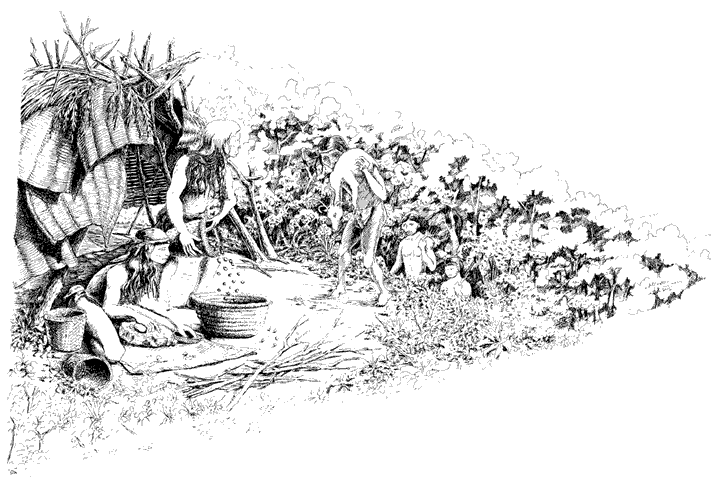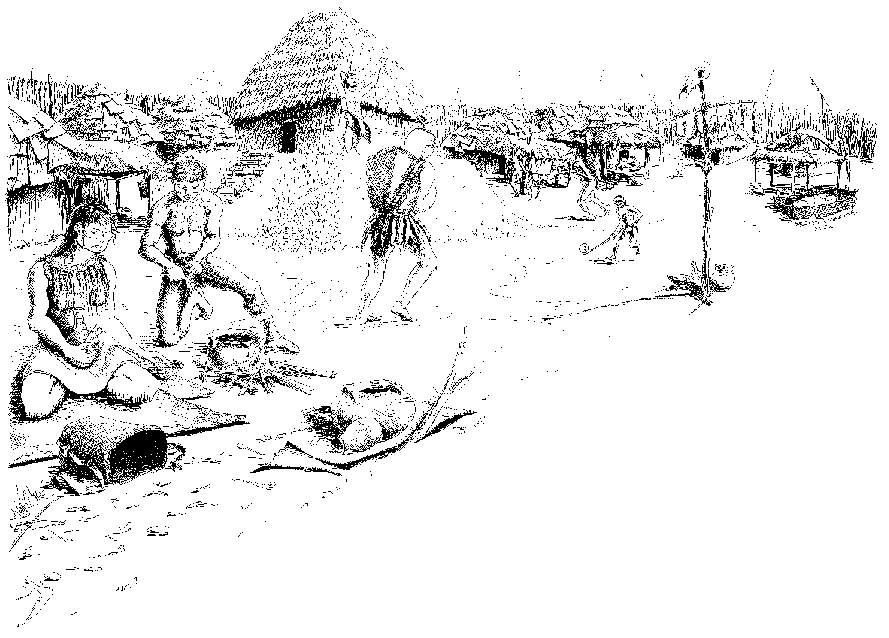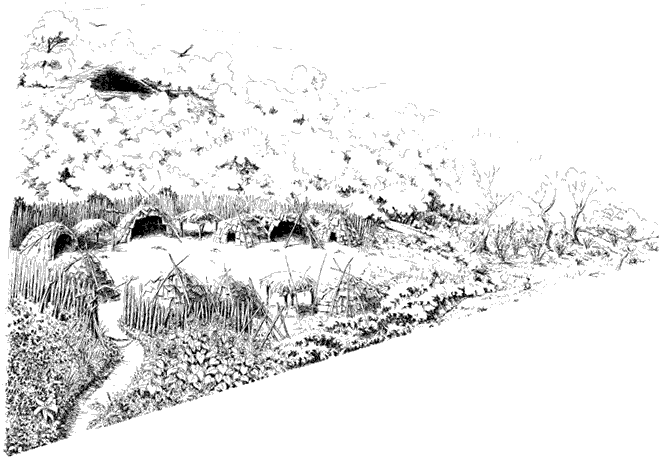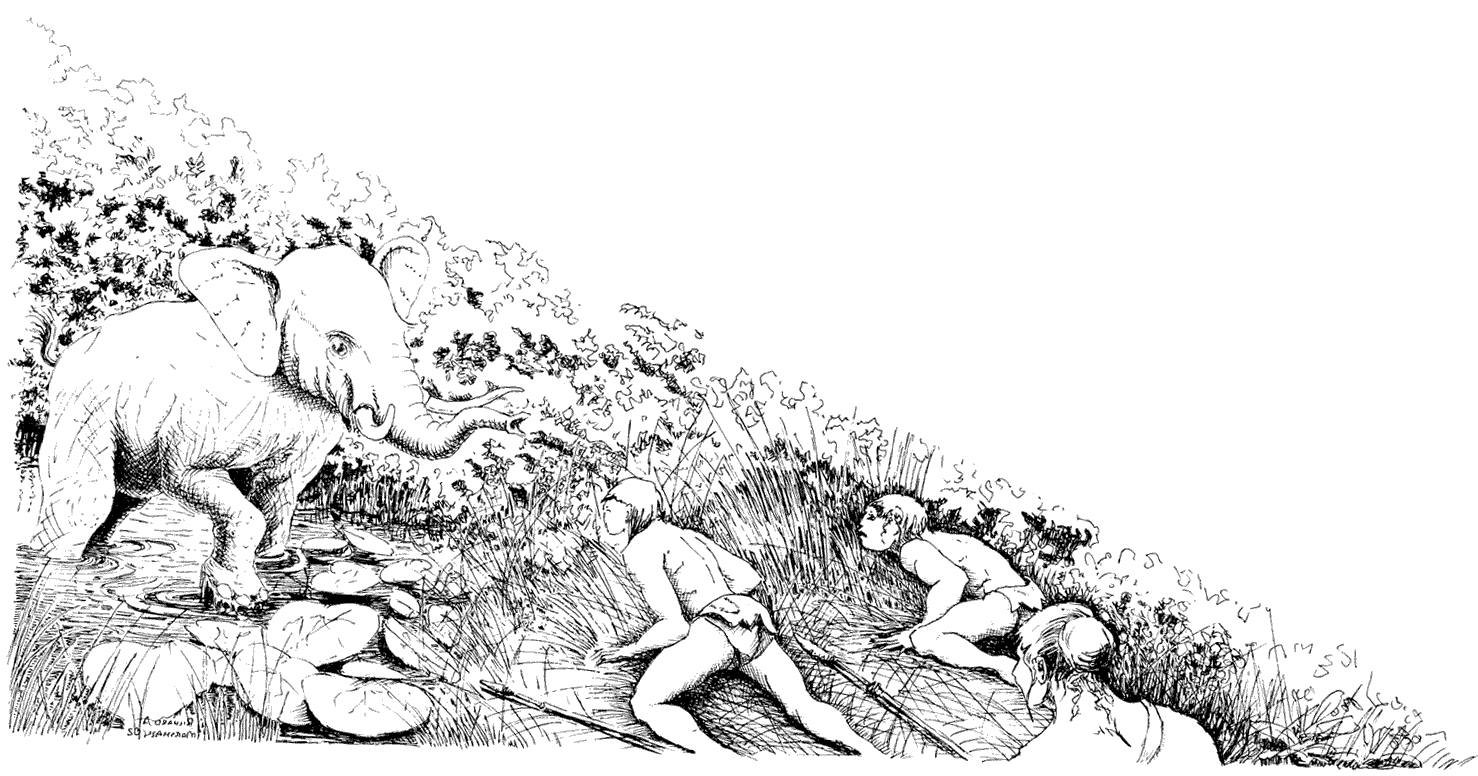How Did The Mississippian People Use Animal Bones
Almost all that is known about the North American indigenous peoples before European contact comes from the bailiwick of archaeology. Archaeology is that branch of anthropology that investigates people's past past studying their material remains. Defective written records, archaeologists could not give most of the prehistoric groups specific names. Therefore, archaeologists created names such as Paleo-Indian, Middle Woodland, Mississippian, Marksville, and Plaquemine to identify distinctive pre-contact Native American groups by culture and time of existence.
During the prehistoric period that began some 12,000 years ago in present-solar day Mississippi, Native Americans were the only inhabitants in the surface area. There are over nineteen,000 prehistoric archaeological sites recorded in Mississippi, and one section of the country, the Yazoo Bowl (Mississippi Delta), boasts one of the highest concentrations of prehistoric archaeological sites in the globe.
Prehistoric sequence
The earliest period is named the Paleo-Indian menses, which dates from approximately x,000 B.C. to 8,000 B.C. During this period, the landscape and accompanying design of human being occupation were considerably different from that of recent times. The colder and wetter climate supported vegetation and wild animals unlike that of today. Evergreen forests of bandbox and fir were common. Mastodon and bison roamed open up grasslands. People of this period organized in pocket-size bands and were nomadic, following the movements of the large animals that they hunted for food and shelter. Their major hunting weapon was a wooden spear shaft tipped with a medium- to fine-chipped stone betoken.
Every bit the climate warmed to one more than feature of today'south climate, material culture indicates a lifestyle that became increasingly more than sedentary. This pattern began in what is named the Archaic menstruation (circa 8,000 B.C. to 500 B.C.) and continued into the Woodland (circa 500 B.C. to A.D. 1000) and Mississippian (circa A.D. 1000 to 1550) periods. Click hither for a general summary of the characteristics of prehistoric periods. (Acrobat PDF)
Native Americans had established thousands of pre-contact settlements in Mississippi considering of the area's favorable ecology factors: arable plant and animal life, warm climate, fertile soils, and navigable rivers and streams. In 1540 during the Hernando de Soto trek, approximately 200,000 Natives lived in the expanse known today every bit Mississippi. Primarily considering of diseases introduced by the Spaniards, the Native American population declined drastically over the adjacent two centuries. By the time the French arrived in Mississippi at the end of the 17th century, but virtually 37,000 Native Americans remained. This population fell to an all-time depression of approximately sixteen,500 past 1750.
Role of archeology
Archaeological investigations at less than 1 percentage of Mississippi'due south prehistoric sites accept provided information on the primeval inhabitants of the area. Archaeological investigations include field surveys to identify and map sites. They also include "testing projects" where limited excavation is undertaken to determine site depth and size based on distribution of artifacts.
More extensive excavations are undertaken at some sites. While extensive excavations provide the most detailed insights into a site and its occupants, the sites for extensive excavation are advisedly selected considering excavation is the most expensive, labor-intensive, time-consuming, and destructive of all archaeological procedures.
Archaeologists clarify the materials recovered from a site to determine the approximate time of occupation, occupational sequence, site activities, and site function(s). Site activities include brute hide processing, cooking, and toolmaking. Site role is the overall apply of the site. Examples of role include temporary camps, permanent villages, and special purpose sites such as cemeteries or bead manufacturing sites.
Archaeologists too want to know how sites interrelate in society to determine how pre-contact populations operated across the landscape. Past plotting the locations of sites exhibiting similar distinctive (diagnostic) artifacts, archaeologists figure out the connections among the indigenous groups.
Artifacts, ecofacts, and features
The site materials that archaeologists examine are known as artifacts, ecofacts, and features.
Artifacts are objects made, modified, or used by humans. Ceramics and lithics (stone) are the ii almost oft encountered types of artifacts. Other categories include items made of bone, antler, forest, and metal.
The ceramics category includes clay objects that were heated (fired) in order to make the objects strong and resistant to moisture. Pottery is the about mutual type of ceramic found at sites and it is usually shattered vessels. Ceramic vessels were used for cooking, eating, and storage. Vessel fragments, called sherds (pronounced shurds), can be quite informative as detail pottery types tin can often be attributed to specific groups and time periods. Other artifacts in the ceramics category range from dirt pipes, beads, and figurines to the remains of fire hearths and firm walls. Thus, ceramics help archaeologists determine the chronological position, cultural amalgamation, and function of a site.
The lithics category includes rock artifacts. It encompasses a wide variety of items, from large stone axes to projectile points (spear, dart, and arrow) and the tiniest of stone drill bits. The by-products of stone tool production, such as stone chips and flakes, also fall into this category. Projectile points can often be placed into established types that relate to specific fourth dimension periods. Some stone tools help determine site role because they can be attributed to a detail use such as animal hibernate working, woodworking, cut, or drilling.
Ecofacts, items such as bone, wood, found seeds, and pollen that may occur naturally at a site, besides assist archaeologists determine how a site was used. Charcoal is particularly important in determining a site's historic period. Subjected to radiocarbon (C-fourteen) testing, such materials tin can produce a relatively accurate appointment for site occupation.
Features are defined as permanent fixtures such as fire hearths, storage pits, and mail holes that, unlike artifacts and ecofacts, are not easily removed. They generally have to exist excavated and recorded on-site and are important to the determination of site use. For instance, post hole patterns tin reveal the presence of a structure at a site. The size and shape of the structure can give clues to the site's apply and time period.
Context is critical
Archaeologists define context as the human relationship of artifacts and other cultural remains to each other and to their surroundings. The proper recording of context is essential during scientific digging and is one of the main reasons why excavating is such a tedious and tedious procedure.
Because a site was frequently occupied at different fourth dimension periods, contextual data is used to help archaeologists group artifacts associated with a item time menstruation, as well as to differentiate materials from dissimilar time periods. This data also allows the archaeologist to better understand what activities were carried out at the site, in what areas of the site they were carried out, and how various activities may have been interrelated.
An archaeological site must be idea of as a not-renewable resource; that is, one time it has been excavated it is destroyed and gone forever. Whatever records were made during the earthworks procedure are all that remain of the site. For that reason, site recording must be extensive and meticulous.
It is unacceptable and illegal for people to indiscriminately dig at archaeological sites. Whether earthworks is washed out of curiosity or for the removal of artifacts, this activity causes irreparable damage to sites. Many of import sites have been destroyed or badly damaged by looters and grave robbers. This vandalism occurs at Native American burying sites since ceramic vessels and other desirable items were sometimes included with an individual at burying. Sites with mounds are specially vulnerable because of their high visibility. Because indiscriminate earthworks destroys vital contextual clues, it reduces a site'south potential for providing of import archaeological information.
Archaeological research must continue in order to increment our knowledge of the prehistory of Mississippi. Thus, the remaining sites in Mississippi must be properly preserved and protected. While Mississippi contains a wealth of prehistoric archaeological sites, many of them take been damaged past natural and human activities. Site damage is acquired by naturally occurring soil erosion and, more oftentimes, past agricultural practices (deep plowing and land leveling) or structure activities related to country development.
Although state and federal laws help protect archaeological resources, an informed and caring public is as important in preserving the remaining sites in Mississippi.
David Morgan, archaeologist, is an historian at the Sometime Capitol Museum, Mississippi Section of Archives and History.This commodity was updated in 2021.
-

Ceramic vessels were used for cooking, eating, and storage. Drawing past Richard Marshall
-

Outset in the Primitive catamenia, lifestyles among the Indians became more than sedentary and socially circuitous. Cartoon by Richard Marshall.
-

Indians had established thousands of prehistoric settlements in Mississippi because of the area'southward favorable environmental factors. Cartoon by Richard Marshall.
-

In the Paleo-Indian period, mastodons roamed open up grasslands. Drawing by Richard Marshall.
-

Excavation on the De Soto National Woods in southeast Mississippi, 2001. The digging is a "Passports In Time" program of the U.South. Department of Agronomics Forest Service. Photograph courtesy USDA Forest Service.
Source: http://www.mshistorynow.mdah.ms.gov/issue/archaeology-and-prehistoric-mississippi
Posted by: taylorduress.blogspot.com

0 Response to "How Did The Mississippian People Use Animal Bones"
Post a Comment